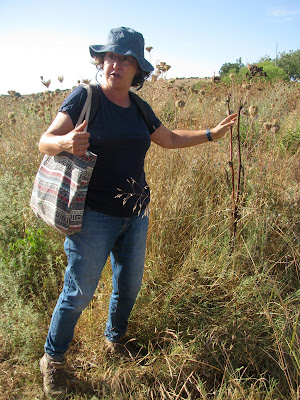My friend Jo discovered her passion for nature ten years ago and has since
gained several years of experience guiding for Neot Kedumim Biblical Nature
Reserve and
Park Ariel Sharon. Last year, during Covid-19, she started
Nature 'n Nosh, a
tour for small groups that allows you to experience the plants, flowers and
trees in the wild Israeli landscape by tasting them, smelling them and hearing
their stories. I was lucky enough to join one of her recent tours.
We started the tour at a small grove on the edge of Modi'in, the city
where we both live. Jo began by telling us that every plant has a story to
tell and that by going back to a plant's roots, we can gain an
understanding of the history and culture around us. She pointed out the
Carob tree, above, whose fruit will ripen only in October. We learnt that
the word carob is connected to the word carat, a modern unit of
weight for gemstones like diamonds. This is not to be confused
with karat, which is a measure of gold purity. The word carat
derives from the Greek word keration meaning fruit of the carob.
The Carob tree, or locust tree, is an evergreen tree with an edible pod
containing seeds. Carob seeds apparently have a uniform weight of 0,20
grams, and therefore old civilisations used these seeds as a reference
weight for precious gemstones and for weighing other small weight items.
One carob seed equals one carat and therefore one carat equals 0,20 grams.

She went on to show us the Dwarf mesquite tree, above, a tree that actually
looks like a shrub, which grows up to a height of 20-100cm. The root system of
this plant is very wide and deep, and actually looks like a tree trunk with
the branches growing down up to a depth of 20 metres. It is only the tree top
which is seen above the ground. The fruit of the tree is edible. The Hebrew
name of the tree is ינבוט, from the Arabic
yanbut, which probably
derives from
nabata (it sprouted, germinated, grew).
We
spotted the purple Common Globe-thistle, or
Kipudan as it is known in
Hebrew. The
kipod is a hedgehog. Kipod derives from the root
קפד and literally means, "that which rolls itself together". The root קפד
developed from "be drawn together" to "be angry" and "be strict", and from
here we have the common verb הקפיד
hikpid, to be strict or
pedantic.
I have written about the almond tree, the
Shkedia, before. They are the
first fruit trees in Israel to wake from their winter sleep and are a sign that
spring is around the corner. Jo taught us that the Hebrew name of the tree,
Shaked, is connected to what the tree does. A
shakdan (שקדן) is a
diligent person who gets the job done, which is exactly what the
Shkedia
is doing.
Further along we spotted a fig tree, above and below. We learnt that the white
sap we can see when a leaf or stem is broken off can be used as a treatment
for warts. It also has curdling properties like vinegar. Fig trees and
fruit bats provide an excellent example of a dependent relationship in nature.
Fruit bats nightly eat half their body weight in figs and, without these
trees, the fruit bat's food source would quickly be depleted. The fruit bats
return the favour to the fig tree by doing their own share of the work. They
carry their food a short distance away from the tree instead of perching in it
while they eat. The fruit's seeds fall as they eat and another fig tree has
the opportunity to grow. In the case that the bat swallows the seeds, they
pass through the animal's digestive tract unharmed and are expelled in a new
location.



At this point of the tour we passed the synagogue at Umm el-Umdan, above,
which is the second oldest synagogue found in Israel. It is believed to have
been built in the
Hasmonean period. The structure of the synagogue is similar in design and construction to
synagogues excavated at
Gamla,
Masada, and
Herodium, but this synagogue pre-dates them. It originally consisted of three rooms.
In the time of
Herod a square building paved with stone slabs, and whose roof was
supported by eight columns, was constructed over it. Adjacent to the
synagogue is a
mikveh (ritual bath), below, contained within its own
building.
Jo took us over to
Givat Sher, one of Modi'in's most significant and well preserved archaeological sites.
On the way she showed us Wild Carrot or Queen Anne's Lace. We learnt that the
whole plant is edible, including the flower, the root and the leaves. The
root, which is white, can be used to treat jaundice, anaemia and the urinary
system, while the leaf and root can deal with skin problems and acne.
We learnt that the black dot in middle of the Wild Carrot is there to attract
insects. This is the plant's way of ensuring its continuance. By placing a
small clump of brown petals that look like a fly in the middle, it is tempting
other flies and insects to come and check it out.
As an interesting aside, Queen Anne's Lace earned its common name from
a legend that tells of Queen Anne of England (1655-1714) pricking her finger
and drawing a drop of blood while sewing lace.
We saw beautiful flowering Caper shrubs, which bloom from April until
September. The flower opens in the late afternoon hours and remains open for
16-18 hours. The flower buds can be pickled and are regarded as excellent
seasoning. The caper, or צלף in Hebrew, survives even under harsh conditions.
צלף is also the Hebrew word for a sniper or marksman. During pollination the
fruit splits open and shoots out seeds - much like a sniper's weapon.


The wild fennel can be used as a herb to add aroma to all sorts of
vegetable, meat and fish dishes. We spotted the tall cane-like stems that
grow 60cm to 120cm in height, above, though it is currently not flowering.
Wild fennel also has many medicinal properties; as well as enhancing eye
sight it is also a great digestive. It is a rich source of fibre, which
helps you stay fuller for longer, preventing you from cravings and
overeating. The Greeks call it maratho. Marathon is the area south of
Athens where the Greeks won a famous battle against the invading Persian
army in 490 BC. The area probably acquired its name because of its abundant
fennel fields. A young soldier, Pheidippides, ran the 42 kilometres from
Marathon to Athens to announce the triumphant victory, thus inspiring the
eponymous run.
We walked to the top of the hill, stopping on the way to learn about the
Labiatae "lips" herbs. Plants in this family are herbs or shrubs often with an
aromatic smell. Jo showed us an example of the flower which has a mouth
and tongue, the meaning behind the nickname "lips". These plants grow
mainly on rock surfaces and include the
Zuta levana, commonly
known as White micromeria or White-leaved savoury. It is known for its medicinal properties and is particularly good for upset stomachs. We also saw Sharp varthemia, known in Hebrew as כתלה or
Ktella from the name
Kotel or the Western Wall. The plant, which can only be found in Israel, Jordan and the Sinai, grows out of walls or rock surfaces and has an incredible rustic aroma. It is good for heart problems and diabetes - and seems like a very gentle herb to enjoy in tea. Another discovery was Syrian Oregano or Bible Hyssop. The plant is also called
za'atar by association
with its use in the herb-spice mixture of dried herbs, sesame and
sumac for flavouring and
garnish.
Givat Sher contains the remains of ancient settlements from three periods -
late Hellenistic,
Byzantine and
Mamluke, as well as evidence of ancient
agriculture. The hill's name apparently derives from the Arabic word "sur",
which means a wall, and indeed, the hill contains many walled terraces.
However, some people believe that the name Sur is a Hebrew name preserved
throughout the various periods of settlement on the hill.
Close to the
top of the hill we noticed a rusted metal grid on a round rock, above. The
grid is covering a deep cistern that was used for water collection. There was
no spring or other water source in the vicinity of this settlement. Therefore
surface runoff water was collected in cisterns during the rainy season, to be
used throughout the year. There was also a large guard tower constructed of
stones, below. Guard towers, known as
shomerot in Hebrew, were common
in agricultural areas and allowed the farmer to protect his crop when it was
ready to be picked, as well as a place for sleeping and storage.Within the
area are a number of these watchtowers, along with wine presses and numerous
rock cairns, meticulously placed on outcrops of bedrock. This is the only
place in Israel where cairns have been found. They may have been used to
support grape vines in the settlement, in the same way as a pergola does
today.
We stopped at the top of Givat Sher to enjoy a light picnic with
some of the delicacies Jo had brought with her or picked along the
way. She brought out dried Saltbush leaves (
maluach in
Hebrew), a plant that grows near water and in the desert and is
naturally salty, absorbing the salt from its environment. We ate these
toasted, along with pita breads filled with tahina, sumac, milk thistle
seeds, various cut vegetables and more. Freshly brewed tea was flavoured
with different types of honey.
From here it was just a short walk back
to our cars. The tour had been an amazing experience. Jo's passion and
enthusiasm in her guiding made the Nature 'n Nosh experience inspirational,
informative and yet still fun for us all. Her love of nature shines through.
If you fancy joining a Nature 'n Nosh tour, you can contact her
here. I highly recommend it!













































































